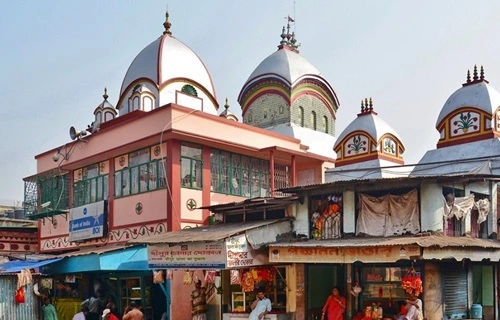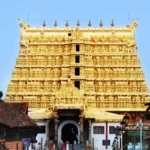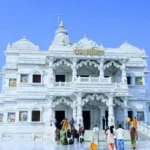Kalighat Temple, one of Kolkata’s most iconic and sacred temples, holds a revered place in the spiritual landscape of India. Located along the banks of the Adi Ganga, Kalighat is dedicated to Goddess Kali, a powerful Hindu deity worshipped for her role in destruction and regeneration. As a destination of immense cultural and religious importance, Kalighat draws thousands of devotees and travelers seeking spiritual peace, history, and a slice of Kolkata’s cultural legacy.
Choosing the right time to visit Kalighat Temple can significantly enrich your experience. Weather, crowd levels, and local festivities all play a role in determining the ideal visit time, offering visitors different atmospheres depending on the season.

Exploring the Temple’s Significance
Kalighat Temple is believed to be one of the 51 Shakti Peethas, the sacred sites where parts of the Goddess Sati’s body fell, according to Hindu mythology. This connection elevates the temple’s status, making it a prime pilgrimage destination and attracting a steady stream of worshippers throughout the year. The temple’s bustling rituals, the resonance of bells, and the aromatic incense in the air create a distinct spiritual aura that visitors cherish.
Best Seasons to Visit Kalighat Temple
1. Winter (November to February)
Winter is widely considered the best season to visit Kalighat Temple. The weather in Kolkata during these months is cool and pleasant, with temperatures ranging from 10°C to 20°C. The comfortable climate allows visitors to explore the temple grounds at ease and makes the experience of standing in line or waiting for rituals much more enjoyable. This period also aligns with the festive season in Kolkata, where devotees and travelers can witness grand celebrations dedicated to Goddess Kali.
One of the most significant events during this time is Kali Puja, held in October or November. Although the temple is crowded with devotees during Kali Puja, the colorful decorations and special rituals make it a spectacular experience. Winter also provides a great opportunity to explore Kolkata’s cultural sites and cuisine as the city comes alive with festivals, fairs, and street food vendors. Many tourists plan their trips around this season to soak in the rich heritage and spiritual energy of the temple and the city.
2. Monsoon (June to September)
The monsoon season brings heavy rains to Kolkata, creating a lush, green environment around the city. Although traveling during this season can be challenging due to rain and humidity, visiting Kalighat Temple in the monsoon offers a more tranquil experience. The temple sees fewer crowds, allowing visitors a more intimate connection with the divine. The ambiance of the temple in the rain, combined with the steady sound of the monsoon showers, creates a serene setting perfect for quiet contemplation and spiritual introspection.
If you’re planning a monsoon visit, it’s advisable to wear rain-appropriate clothing and carry umbrellas or raincoats. Since the temple grounds can become slippery, extra caution is needed, but this season’s calmness and the beautiful surroundings are worth the effort for those seeking a quieter experience.
3. Summer (March to May)
Summer in Kolkata can be intense, with temperatures often exceeding 35°C. Due to the heat, this season sees fewer tourists, making it an option for those who wish to avoid crowds entirely. Visiting Kalighat Temple during summer requires some preparation, but it also allows visitors to explore the temple at a leisurely pace. Early mornings or late evenings are the best times to visit during this season, as the temperatures are cooler and more manageable.
Visitors choosing a summer visit should stay hydrated, wear breathable clothing, and plan their temple trip in the early hours to minimize the effects of the heat. While it may not offer the festive excitement of winter or the monsoon’s tranquility, summer provides a calm experience for visitors seeking solace and uninterrupted time for worship.
Important Festivals and Events
Timing a visit with major temple festivals can add depth to the experience. Kalighat Temple hosts several significant events, including:
- Kali Puja: The most important festival dedicated to Goddess Kali, celebrated in October or November. The temple is decorated with lights, and thousands of devotees gather to participate in grand rituals.
- Durga Puja: While Durga Puja is celebrated citywide in Kolkata, Kalighat Temple sees many worshippers honoring both Goddess Durga and Kali during this festive season, which typically occurs in October.
- Navratri: Another prominent celebration occurring in September or October, dedicated to the divine feminine, where each day is filled with worship and vibrant offerings.
Practical Tips for Visiting Kalighat Temple
- Timing: To avoid large crowds, visit early in the morning or later in the afternoon, especially on weekends and holidays.
- Dress Appropriately: Modest clothing is preferred in Kalighat Temple. Visitors should dress respectfully, as it is a place of worship.
- Stay Cautious: Kalighat Temple can get crowded, especially during festivals, so be mindful of your belongings. It’s wise to keep valuables safe to avoid any inconvenience.
- Explore Nearby: After visiting the temple, explore the surrounding area, which is rich in history and local culture. Bengali street food and sweets, like the iconic Kolkata kathi roll and rosogolla, are must-try delights.
Conclusion
Kalighat Temple is not just a site of worship; it’s a cultural landmark that captures the heart of Kolkata’s spiritual and cultural essence. From the bustling festivities of winter to the introspective calm of the monsoon and the solitude of summer, each season offers a unique experience for visitors. Choose the time that aligns with your preferences, and let the spiritual ambiance of Kalighat Temple leave a lasting impression on your journey through Kolkata.


